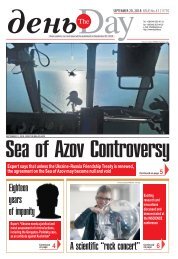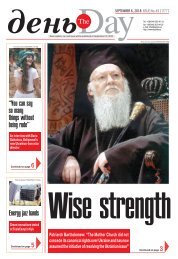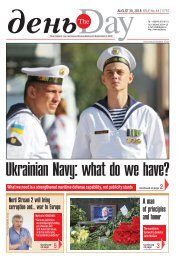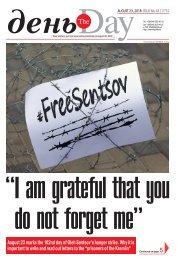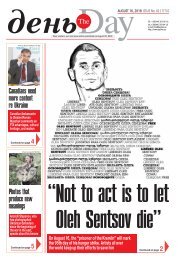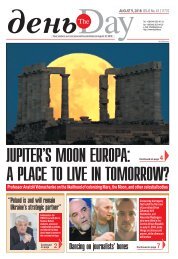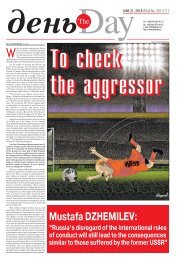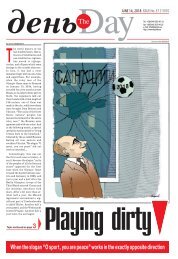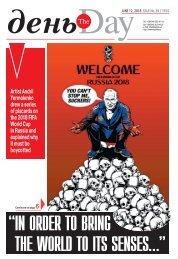#1_1-8
Create successful ePaper yourself
Turn your PDF publications into a flip-book with our unique Google optimized e-Paper software.
8<br />
No.1 JANUARY 16, 2018<br />
TIMEO U T<br />
WWW.DAY.KIEV.UA<br />
Malevich: the second death<br />
Photo from the website WIKIART.ORG<br />
KAZIMIR MALEVICH, SELF-PORTRAIT (1933)<br />
By Dmytro DESIATERYK, The Day<br />
Ukraine rightly counts the genius of avantgarde<br />
Kazimir Malevich (Malevych)<br />
among our own artists. He was born in<br />
Kyiv in 1878, and spent his childhood in<br />
Podillia (Yampil), Kharkiv (Parkhomivka,<br />
Bilopillia), and Chernihiv (Vovchok, Konotop)<br />
governorates. The artist began to paint in Kootop,<br />
inspired by folk embroidery and decorative<br />
paintings. He studied under Mykola Pymonenko at<br />
Kyiv Art School (1895-97). In 1927-30, he taught<br />
at Kyiv Art Institute, where the faculty then<br />
included Mykhailo Boichuk, Viktor Palmov, Fedir<br />
Krychevsky, Vadym Meller, Oleksandr Bohomazov,<br />
and Vasyl Kasiian.<br />
At the same time, Russia, too, is entitled to<br />
consider him as one of its own, as it was there that<br />
he created most of his paintings, including the famous<br />
Black Square, and his exhibitions took place<br />
there. Malevich died there as well in 1935. The urn<br />
with his ashes was buried in the village of Nemchinovka,<br />
Odintsovo District of the Moscow Region,<br />
near the oak where the artist liked to rest. A<br />
wooden cubic monument with a black square was<br />
erected above the grave.<br />
During the war, the grave was lost. Later, its location<br />
was identified by a group of enthusiasts in a<br />
collective farm arable field, so<br />
the commemorative sign, erected<br />
in 1988, had to be placed on<br />
the edge of the forest, approximately<br />
two kilometers from the<br />
actual burial place. It is a white<br />
concrete cube with a red square<br />
on the front side.<br />
However, what the communists<br />
began, the Putin-era<br />
“capitalists” have successfully<br />
completed. The field, the forest,<br />
and Malevich’s burial place<br />
have all been repurposed for<br />
property development. Construction<br />
of the “elite” (of<br />
course) residential block Romashkovo-2<br />
is already close to<br />
completion. The developer denies<br />
all accusations, arguing<br />
that he did not know anything<br />
about the grave. Whether he<br />
knew or not, Malevich’s burial<br />
place was not a protected site at<br />
the time of him obtaining a<br />
building permit.<br />
So, we can state that Malevich<br />
died the second death in<br />
Russia – under road rollers and<br />
bulldozers, under cubic meters of concrete and<br />
bricks. In the end, Moscow’s parasitic bourgeoisie<br />
needs somewhere to live. Why should a grave be out<br />
of bounds?<br />
It brings to mind another scandal that happened<br />
in the beginning of 2015 and had to do with the famous<br />
philosopher Immanuel Kant. A photo then appeared<br />
online of the ruins of a house in Kaliningrad,<br />
Russia (formerly Konigsberg), where the author of<br />
Critique of Pure Reason once lived, carrying an inscription:<br />
“Kant is a loser.”<br />
Is not he? Well, really? For the Putinist regime,<br />
which thinks nothing of human individuality, value<br />
of personality and equality of rights, both Malevich<br />
and Kant are losers, that is, stupid, unnecessary<br />
people. One can pour a layer of concrete over<br />
their graves, why not?<br />
Coming back to Ukraine: in fact, we do not<br />
have much to boast about either. Yes, Kyiv does<br />
already have Malevycha Street (renamed as late as<br />
2012), and a non-descript commemorative sign was<br />
erected in Volodymyro-Lybidska Street of the<br />
capital in 2008, which is collapsing little by little,<br />
and that is all. We have neither a museum nor special<br />
tours, nothing.<br />
And now the former imperial center offers us an<br />
opportunity to look decent, even if only by contrast.<br />
All that is needed is a bit of money and desire.<br />
Photo by Mykola TYMCHENKO, The Day<br />
KYIV DOES ALREADY HAVE MALEVYCHA STREET (RENAMED AS LATE AS 2012), AND A NON-<br />
DESCRIPT COMMEMORATIVE SIGN WAS ERECTED IN VOLODYMYRO-LYBIDSKA STREET OF THE<br />
CAPITAL IN 2008, WHICH IS COLLAPSING LITTLE BY LITTLE<br />
The magic of kindness<br />
Emma Andijewska’s painting poses a real<br />
esthetic mystery to many spectators<br />
By Roman YATSIV<br />
Illustration courtesy of the author<br />
The uncanonical painting of Emma Andijewska<br />
(Andiievska), invisibly tied up with the willful<br />
whirlpools of the author’s existence, poses a real<br />
esthetic mystery to many spectators. A<br />
commonplace person may find it totally<br />
impossible to interpret every subject or symbol of her<br />
pictures. Searching for a “grain of truth” in the<br />
outlandish and grotesque imagination world of a<br />
unique painter and poetess, anyone may well get lost in<br />
the unusual surroundings and ask other wayfarers to<br />
help trace the sources of this metaphorical road.<br />
Emma Andijewska, one of the most brilliant artistic<br />
individualities of today, is really “merciless” as well<br />
as candid. The mistress has been nominated for the<br />
Shevchenko Prize for the books Cities-Jacks, Clockless<br />
Time, Landscapes in the Drawers, Marathon, and<br />
Everyday Life: Periscopes.<br />
Andijewska is undivided in her passions and categorical<br />
in her judgments; she is a bold pioneer on the paths<br />
of verbal and visual forms that shape her inimitable disposition;<br />
she continues to captivate and surprise, creating<br />
painting cycles with an unheard-of speed. For Emma, the<br />
very strategy of painting radically differs from the methods<br />
of the vast majority of artists who plan, sketch, and<br />
sometimes rack their brains over the choice of formal instruments<br />
to implement a pre-considered idea. This path<br />
would run counter to Andijewska’s inner nature. She has<br />
been painting since she began to write poems and short<br />
stories, stubbornly overcoming stereotypes and the<br />
slightest hesitations about any “academic rules” in art.<br />
She paints when the reactor of her existence generates<br />
a great deal of energy which is to be put into a structured<br />
poetic or painting form. Therefore, Andijewska has been<br />
revealing her own world-view for many decades in two<br />
concurrent dimensions, which shapes her integral poetic<br />
and philosophical image.<br />
It is rather difficult to systemize Andijewska’s artworks<br />
(thousands of pictures and drawings) in terms of<br />
genres and formal expressive means. It is a good idea<br />
to scrutinize her art in the dynamics of the author’s passion<br />
in general, when certain associations were being<br />
born, senses were forming, new ways of mental organization<br />
were being sought. From the first solo exhibit<br />
in Munich (1956) until the next one in New York<br />
(1989), poetry and prose books were outrunning paintings,<br />
but that period saw the birth of a large number of<br />
allegoric characters which filled the mystifying author’s<br />
subjective reality all over the space of her artistic experiences.<br />
By the late 1980s the ratio of painting had<br />
risen so much that Andijewska began to produce not only<br />
poetic books, but also what can be called “visual poetry<br />
albums,” with due account of the genres and<br />
themes of those publications.<br />
What are these books about, why are they important<br />
to the authoress, and how can we qualify Andijewska’s<br />
painting canvases? To answer these questions, one<br />
should abstract away again from customary approaches<br />
to other artists’ painting practices. The motivational factor<br />
for the artist is not setting a certain professional goal<br />
but expressing something that is immanent, specific, and<br />
typical of the author’s existence, of a certain emotional<br />
condition, or irrational in the metaphysics of time or<br />
place. Undoubtedly, the world order in Andijewska’s<br />
artistic space derives from her mythological thinking and<br />
is kept afloat by a specific poetic world-view and a sharp<br />
visualization of the invisible.<br />
Whenever you want to systemize the themes and<br />
genres of Andijewska’s paintings, you face the following<br />
problem: where, when, and how did the basic form<br />
emerge – the form that gave birth to characters, objects,<br />
and some quaint creatures with which the authoress<br />
models certain mythological plots? Naturally, fictional<br />
images are neither concretely emotional, nor decorative,<br />
nor provocative. And their symbolism is also entirely<br />
different from the classical interpretation of this<br />
historical art term. The “population” of Andijewska’s<br />
imaginary world is, above all, kindhearted (the mirror<br />
reflection of the authoress’ value-oriented imperative).<br />
The artist “describes” with a shade of humor her<br />
daily routine and hyperbolizes secondary (by the hierarchy<br />
of meanings) details. In the 2001 issue of the Munich-based<br />
publication In Bild, prepared together with<br />
German photo artist Lisa Pfahler-Scharf, Emma shows<br />
self-portrait-style paraphrases with her own pictures,<br />
which proves organicity of the cherished poetic world<br />
with her personal lifestyle, character, self-irony, and<br />
burlesque. It is not necessary to call all the elements of<br />
this plastique syntax skillfully designed in both light<br />
and color. Round shapes developed into the formless<br />
masses of figures and heads that featured “wrongly” set<br />
kind and sorrowful eyes. Hermetic dynamic structures,<br />
reinforced with an expressive color, became the<br />
“banquet” of the painting temperament of Andijewska<br />
as a self-sufficient poetess and artist who is frank in her<br />
judgments and creative manifestations.<br />
At the same time, Andijewska changes the structure<br />
of a metaphysical environment in another group<br />
of pictures, expressing more complicated philosophical<br />
senses. It is particularly noticeable in the “Crucifix” cycle<br />
of drawings (2014-15), where a New Testament subject<br />
is treated in a rather unexpected way, and in “The<br />
1,001st Night” (2008-10). Yet, regardless of the thematic<br />
factor in painting, graphic artistry, and carpetmaking,<br />
which the artist also turns to, one can always<br />
see the sign of magic which combines the various<br />
states of her existence, the different levels of reacting<br />
to life, the different intonations of joy and sadness that<br />
accompany the life path of a great Ukrainian lady. By<br />
conceptual indications, the art of Emma Andijewska<br />
draws remote formal parallels with abstract expressionism,<br />
lyrical abstraction, and informalism (art informel),<br />
but none of these art trends in the second half<br />
of the 20th century comprises a concentrated poetic component<br />
which is the quintessence of the phenomenon of<br />
Andijewska – an inimitable and unsurpassable person<br />
on the all too complex platform of world perception.<br />
Roman Yatsiv is a pro-rector of the Lviv<br />
Academy of Arts<br />
UKRAINIAN NEWS IN ENGLISH<br />
www.day.kiev.ua incognita.day.kiev.ua<br />
FOUNDER AND PUBLISHER:<br />
UKRAINIAN PRESS GROUP LIMITED LIABILITY COMPANY<br />
Published since May 27, 1998.<br />
Свiдоцтво про перереєстрацiю КВ № 21448-11248 ПР<br />
вiд 27 липня 2015 року<br />
Larysa Ivshyna, Editor-in-Chief, Den<br />
e-mail: chedit@day.kiev.ua<br />
Hanna Sheremet, Deputy Editor-in-Chief<br />
Anna Mazurenko, Director,<br />
Ukrainian Press Group LLC<br />
Anna Motoziuk, Editor,<br />
English Language Bureau<br />
Olha Pavliei, Technical Editor<br />
Borys Honcharov, George Skliar, Taras Shulha,<br />
Nadia Sysiuk, Oksana Sabodash, Translators<br />
Maryna Khyzhniakova, Proofreader<br />
Marharyta Motoziuk, Designer<br />
Alla Bober, Responsible Secretary<br />
Mykola Tymchenko, Photography Editor<br />
Mailing address: prosp. Peremohy, 121d, Kyiv 03115, Ukraine<br />
Telephone: +38(044) 303-96-19<br />
Fax: +38(044) 303-94-20<br />
Advertising: +38(044) 303-96-20; e-mail: ra@day.kiev.ua<br />
Subscriptions: +38(044) 303-96-23; e-mail: amir@day.kiev.ua<br />
E-mail: time@day.kiev.ua<br />
Subscription index: 40032<br />
Ukrainian Press Group LLC<br />
Code 24249388<br />
Raiffeisen Bank joint-stock company<br />
MFO 380805<br />
A/С 26007478064<br />
Responsibility for the accuracy of facts, quotations, personal names, and other information is borne by the authors of publications and in advertising<br />
materials by the advertiser. The views expressed in signed articles do not necessarily reflect those of the editors. Submitted materials are not returned<br />
and not reviewed. The editors retain the right to edit materials. When citing Day materials, reference to The Day is mandatory. ©Den.




